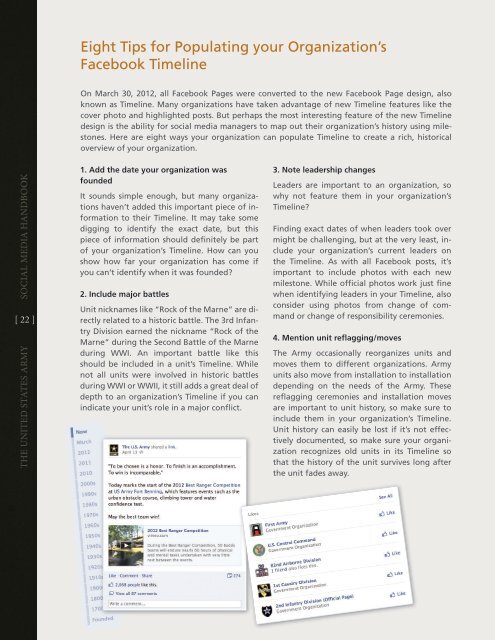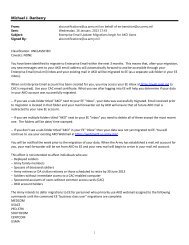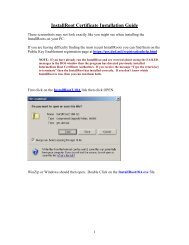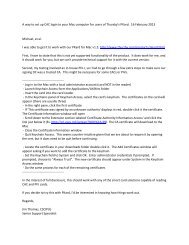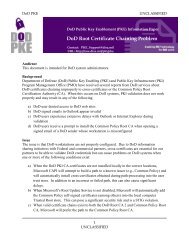U.S. Army Social Media Handbook - 25th Infantry Division - U.S. Army
U.S. Army Social Media Handbook - 25th Infantry Division - U.S. Army
U.S. Army Social Media Handbook - 25th Infantry Division - U.S. Army
You also want an ePaper? Increase the reach of your titles
YUMPU automatically turns print PDFs into web optimized ePapers that Google loves.
Eight Tips for Populating your Organization’s<br />
Facebook Timeline<br />
On March 30, 2012, all Facebook Pages were converted to the new Facebook Page design, also<br />
known as Timeline. Many organizations have taken advantage of new Timeline features like the<br />
cover photo and highlighted posts. But perhaps the most interesting feature of the new Timeline<br />
design is the ability for social media managers to map out their organization’s history using milestones.<br />
Here are eight ways your organization can populate Timeline to create a rich, historical<br />
overview of your organization.<br />
The United States <strong>Army</strong> social media handbook<br />
[ 22 ]<br />
1. Add the date your organization was<br />
founded<br />
It sounds simple enough, but many organizations<br />
haven’t added this important piece of information<br />
to their Timeline. It may take some<br />
digging to identify the exact date, but this<br />
piece of information should definitely be part<br />
of your organization’s Timeline. How can you<br />
show how far your organization has come if<br />
you can’t identify when it was founded?<br />
2. Include major battles<br />
Unit nicknames like “Rock of the Marne” are directly<br />
related to a historic battle. The 3rd <strong>Infantry</strong><br />
<strong>Division</strong> earned the nickname “Rock of the<br />
Marne” during the Second Battle of the Marne<br />
during WWI. An important battle like this<br />
should be included in a unit’s Timeline. While<br />
not all units were involved in historic battles<br />
during WWI or WWII, it still adds a great deal of<br />
depth to an organization’s Timeline if you can<br />
indicate your unit’s role in a major conflict.<br />
3. Note leadership changes<br />
Leaders are important to an organization, so<br />
why not feature them in your organization’s<br />
Timeline?<br />
Finding exact dates of when leaders took over<br />
might be challenging, but at the very least, include<br />
your organization’s current leaders on<br />
the Timeline. As with all Facebook posts, it’s<br />
important to include photos with each new<br />
milestone. While official photos work just fine<br />
when identifying leaders in your Timeline, also<br />
consider using photos from change of command<br />
or change of responsibility ceremonies.<br />
4. Mention unit reflagging/moves<br />
The <strong>Army</strong> occasionally reorganizes units and<br />
moves them to different organizations. <strong>Army</strong><br />
units also move from installation to installation<br />
depending on the needs of the <strong>Army</strong>. These<br />
reflagging ceremonies and installation moves<br />
are important to unit history, so make sure to<br />
include them in your organization’s Timeline.<br />
Unit history can easily be lost if it’s not effectively<br />
documented, so make sure your organization<br />
recognizes old units in its Timeline so<br />
that the history of the unit survives long after<br />
the unit fades away.


